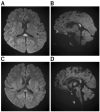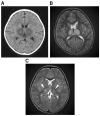A Comprehensive Review of Pediatric Acute Encephalopathy
- PMID: 36233788
- PMCID: PMC9570744
- DOI: 10.3390/jcm11195921
A Comprehensive Review of Pediatric Acute Encephalopathy
Abstract
Acute encephalopathy typically affects previously healthy children and often results in death or severe neurological sequelae. Acute encephalopathy is a group of multiple syndromes characterized by various clinical symptoms, such as loss of consciousness, motor and sensory impairments, and status convulsions. However, there is not only localized encephalopathy but also progression from localized to secondary extensive encephalopathy and to encephalopathy, resulting in a heterogeneous clinical picture. Acute encephalopathy diagnosis has advanced over the years as a result of various causes such as infections, epilepsy, cerebrovascular disorders, electrolyte abnormalities, and medication use, and new types of acute encephalopathies have been identified. In recent years, various tools, including neuroradiological diagnosis, have been developed as methods for analyzing heterogeneous acute encephalopathy. Encephalopathy caused by genetic abnormalities such as CPT2 and SCN1A is also being studied. Researchers were able not only to classify acute encephalopathy from image diagnosis to typology by adjusting the diffusion-weighted imaging/ADC value in magnetic resonance imaging diffusion-weighted images but also fully comprehend the pathogenesis of vascular and cellular edema. Acute encephalopathy is known as a very devastating disease both medically and socially because there are many cases where lifesaving is sometimes difficult. The overall picture of childhood acute encephalopathy is becoming clearer with the emergence of the new acute encephalopathies. Treatment methods such as steroid pulse therapy, immunotherapy, brain hypothermia, and temperature control therapy have also advanced. Acute encephalopathy in children is the result of our predecessor's zealous pursuit of knowledge. It is reasonable to say that it is a field that has advanced dramatically over the years. We would like to provide a comprehensive review of a pediatric acute encephalopathy, highlighting advancements in diagnosis and treatment based on changing disease classification scenarios from the most recent clinical data.
Keywords: acute encephalopathy; brain hypothermia; convulsions; pediatrics.
Conflict of interest statement
The authors declare no conflict of interest.
Figures




References
-
- Slooter A.J.C., Otte W.M., Devlin J.W., Arora R.C., Bleck T.P., Claassen J., Duprey M.S., Ely E.W., Kaplan P.W., Latronico N., et al. Updated nomenclature of delirium and acute encephalopathy: Statement of ten Societies. Intensive Care Med. 2020;46:1020–1022. doi: 10.1007/s00134-019-05907-4. - DOI - PMC - PubMed
-
- Hoshino A., Saitoh M., Oka A., Okumura A., Kubota M., Saito Y., Takanashi J., Hirose S., Yamagata T., Yamanouchi H., et al. Epidemiology of acute encephalopathy in Japan, with emphasis on the association of viruses and syndromes. Brain Dev. 2012;34:337–343. doi: 10.1016/j.braindev.2011.07.012. - DOI - PubMed
-
- Kasai M., Shibata A., Hoshino A., Maegaki Y., Yamanouchi H., Takanashi J.I., Yamagata T., Sakuma H., Okumura A., Nagase H., et al. Epidemiological changes of acute encephalopathy in Japan based on national sur-veillance for 2014–2017. Brain Dev. 2020;42:508–514. doi: 10.1016/j.braindev.2020.04.006. - DOI - PubMed
Publication types
LinkOut - more resources
Full Text Sources

